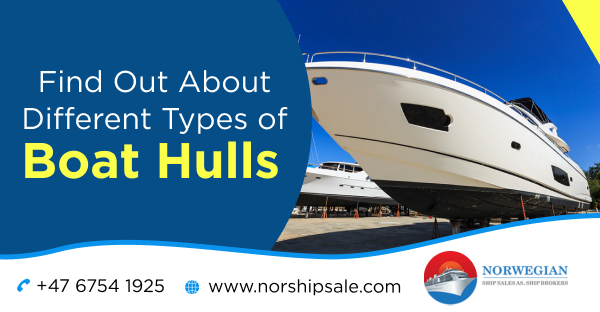Boats are available in a variety of sizes and designs, each one created for a particular use or set of requirements. The hull of a ship is one of the most critical aspects of design. The boat’s performance in the water, stability, and capacity to manage various sea conditions are all determined by the hull. We’ll examine numerous boat hull types in this article, highlighting their distinctive qualities and applicability for diverse uses. Understanding boat hulls is crucial, whether you’re a seasoned boater or you’re just beginning your maritime adventure, and want to invest in a ferry for sale.

Top Types of Boat Hulls
In this section, get a complete idea of the different types of ship hulls and their designs.
1. Displacement Hull
A smooth and stable ride is produced by displacement hulls, which are designed to displace water as the boat travels ahead. Typically, sailboats, trawlers, and many classic cruising vessels have these hulls. Displacement hulls are renowned for their fuel effectiveness and stability in choppy waters. They are great for long-distance sailing and ocean journeys, but not for high speeds.
2. Planing Hull
In contrast to displacement hulls, which are made to move water, planing hulls are made to glide over the surface of the water. They are renowned for their speed and agility and are frequently seen on small to medium-sized powerboats. Flat or slightly V-shaped, planing hulls enable the boat to go at fast speeds by skimming the water’s surface. They are perfect for leisure cruising, wakeboarding, and water skiing.
For more information and assistance when buying ferries for sale, you can get in touch with top shipbrokers to gain knowledge.
3. Semi-Displacement Hull
Planing and displacement hulls’ specific characteristics are combined in semi-displacement hulls. They nevertheless provide the stability and comfort of a displacement hull while being capable of moderate speeds. The majority of powerboats, including some bigger cruising yachts and trawlers, have these hulls. Semi-displacement hulls are adaptable and suited for a variety of pursuits, from sport fishing to leisurely cruising.
4. Trimaran Hull
A centre hull and two smaller outrigger hulls make up the three hulls of a trimaran. Trimarans can cruise at high speeds and maintain stability thanks to this design’s balance between the two. For long-distance cruising and racing, trimarans are a common choice for sailors seeking a balance of performance and comfort.
5. Catamaran Hull
Two parallel hulls are joined by a bridge deck on a catamaran. Compared to single-hull boats, this design provides great stability and enhanced speed. Sailboats and powerboats frequently use catamarans. They are renowned for their effectiveness and their skill in navigating rough waters. In particular, catamaran sailboats are praised for their comfort and speed.
6. Pontoon Hull
Pontoon hulls are made up of several pontoons, which are cylindrical tubes joined to a flat deck. These hulls are well-liked for leisurely cruising and entertainment because they provide great stability. Larger groups of passengers can board pontoon boats because of their space. They are renowned for being adaptable, with some versions having features for fishing, water activities, or even as party boats.
7. Deep-V Hull
Today’s modern boats most frequently have hulls with V-shaped bottoms. They are made to slice through the water quickly and offer a smoother ride, even at high speeds in choppy waters. Powerboats or motorboats made of fiberglass are frequent examples. These boats often have a larger engine, but to go at the same speed as flat-bottom hulls, they need more power. V-shaped boats are ideal for fishing in calm waters since they have a little draft. The deep V shape also enables them to travel quickly through choppy waters. On occasion, it may roll or bank sharply.
8. Multi-Hull
Multi-hulled boats will be your most obvious choice if you’re seeking quick ferries for sale. Catamarans, trimarans, and pontoon boats fall into this category. These boats’ wider stances help them to be more stable on the water. The use of two or more hulls improves speed and facilitates cutting through the water. Boats with many hulls require extra space while turning or maneuvering.
Take away
In conclusion, choosing the correct boat for your boating needs requires an understanding of the various boat hull types. There is a boat design to fit your preferences and hobbies, whether you’re interested in stable displacement hulls, fast planing hulls, or adaptable semi-displacement hulls. Additionally, if you’re thinking about getting into the ferry business, researching the available ferries for sale will enable you to choose the boat that best suits your operating needs. Whatever your boating objectives, a safe and happy trip on the water depends on having the proper hull design.

